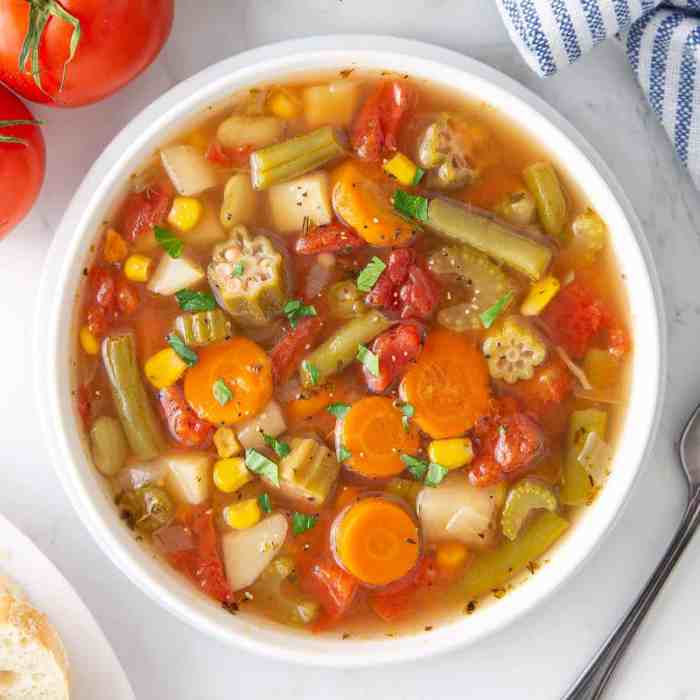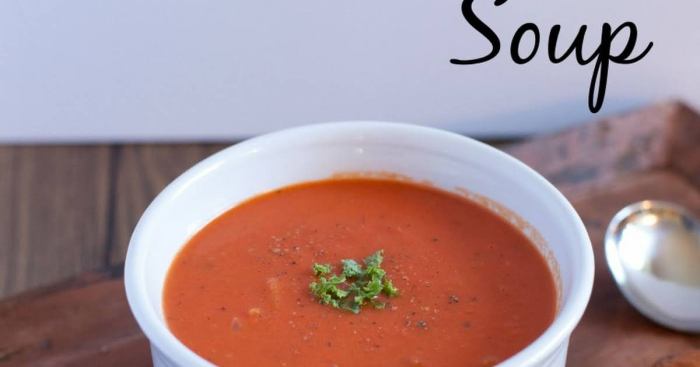Vegetable Soup Recipe Variations with Tomato Juice
Vegetable soup recipe with tomato juice – Tomato juice forms a versatile base for vegetable soup, lending its characteristic tang and sweetness to a variety of flavor profiles. This article explores three distinct variations – Italian, Mexican, and Asian-inspired – highlighting ingredient choices, cooking methods, and serving suggestions to inspire your culinary creativity.
Recipe Variations: Italian, Mexican, and Asian-Inspired Vegetable Soups, Vegetable soup recipe with tomato juice

Source: theblondcook.com
Each variation utilizes tomato juice as a foundational element, yet showcases unique flavor profiles achieved through distinct ingredient selections and seasonings. The tomato juice provides a unifying acidic base, complementing and enhancing the flavors of the vegetables in each recipe.
| Ingredient | Italian Variation | Mexican Variation | Asian-Inspired Variation |
|---|---|---|---|
| Tomato Juice | 1 (46 oz) can | 1 (46 oz) can | 1 (46 oz) can |
| Vegetables | Diced carrots, zucchini, celery, spinach, cannellini beans | Diced corn, bell peppers (red and green), black beans, jalapeño | Diced bok choy, shiitake mushrooms, bamboo shoots, edamame |
| Aromatics | Garlic, onion, oregano, basil | Garlic, onion, cumin, chili powder | Ginger, garlic, soy sauce, sesame oil |
| Other Ingredients | Pasta (small shells or ditalini), Parmesan cheese | Lime juice, cilantro, avocado | Rice noodles, cilantro, lime wedges |
Substitution Notes: Many substitutions are possible based on dietary needs and preferences. For example, vegetable broth can replace some of the tomato juice to reduce acidity. Lentils or other beans can substitute for those listed. Feel free to experiment with different herbs and spices to customize the flavors.
Cooking Methods and Techniques: Stovetop vs. Slow Cooker

Source: googleusercontent.com
Both stovetop and slow cooker methods yield delicious results, each offering unique advantages and disadvantages.
- Stovetop Method:
- Advantages: Faster cooking time, more control over the cooking process, better for smaller batches.
- Disadvantages: Requires more hands-on attention, may need adjustments during cooking.
- Slow Cooker Method:
- Advantages: Minimal hands-on time, excellent for larger batches, develops deeper flavors.
- Disadvantages: Longer cooking time, less control over the cooking process.
Step-by-Step Stovetop Preparation (Italian Variation):
- Sauté onions and garlic in olive oil until softened (5 minutes).
- Add carrots, zucchini, and celery; cook until slightly tender (5-7 minutes).
- Pour in tomato juice, add oregano and basil, bring to a simmer.
- Add cannellini beans and simmer for 15-20 minutes, or until vegetables are tender.
- Stir in cooked pasta during the last few minutes of cooking.
- Season with salt and pepper to taste.
- Serve with grated Parmesan cheese.
Visual Representation of Preparation Stages: The initial stage shows a vibrant mix of colorful vegetables being sautéed. As the soup simmers, the colors deepen and blend, creating a rich, reddish-orange hue. The vegetables soften and become tender, their textures changing from firm to yielding.
Ingredient Selection and Sourcing
Choosing high-quality ingredients is crucial for a flavorful and nutritious soup. The following table details recommended vegetables, categorized by type, along with nutritional information and sourcing tips.
| Ingredient | Quantity (per serving) | Nutritional Value (approximate per serving) | Sourcing Tips |
|---|---|---|---|
| Tomato Juice | 1 cup | Vitamins A & C, Lycopene | Look for low-sodium options; consider organic |
| Carrots (example) | ½ cup diced | Vitamin A, Fiber | Choose locally grown, seasonal carrots |
| Celery (example) | ¼ cup diced | Vitamins K & C | Select firm, crisp stalks |
| Other Vegetables (various) | As per recipe | Varying vitamins and minerals depending on the vegetables chosen. | Prioritize seasonal and locally sourced produce whenever possible. |
Serving Suggestions and Enhancements
Elevate your vegetable soup with creative serving suggestions and flavor enhancements.
A simple vegetable soup with tomato juice offers a refreshing, light meal. For a heartier option, consider adding legumes; the depth of flavor in a spanish garbanzo soup recipe provides excellent inspiration. This could easily be adapted to incorporate the tomato juice base, creating a unique twist on a classic vegetable soup.
- Serve with crusty bread for dipping.
- Garnish with fresh herbs (parsley, chives, cilantro) and a dollop of sour cream or yogurt.
- Add a sprinkle of toasted nuts or seeds for added texture and flavor.
Flavor Enhancements: Experiment with different herbs and spices like thyme, rosemary, smoked paprika, or a dash of hot sauce to tailor the soup to your preference. A squeeze of lemon or lime juice can brighten the flavors.
Restaurant-Style Presentation: Serve the soup in a shallow bowl, garnished with a swirl of crème fraîche or a sprinkle of finely chopped fresh herbs. A few croutons or a small piece of grilled cheese can be placed on the side for added visual appeal and texture.
Storage and Reheating
Proper storage and reheating techniques are essential to maintain the quality and flavor of your vegetable soup.
Storage: Allow the soup to cool completely before storing it in airtight containers in the refrigerator for up to 3-4 days. Avoid using metal containers, as they can affect the taste.
Reheating: Reheat gently on the stovetop or in the microwave, stirring occasionally to prevent scorching. Avoid boiling, as this can make the soup watery. Adding a splash of broth or water may be necessary if the soup becomes too thick during reheating. To prevent watery soup, avoid over-simmering and allow the soup to cool completely before storing.
FAQ Corner: Vegetable Soup Recipe With Tomato Juice
Can I use canned diced tomatoes instead of tomato juice?
Yes, you can substitute canned diced tomatoes, but you might need to adjust the liquid accordingly. Start with a smaller amount and add more broth or water as needed to achieve your desired consistency.
How long can I store leftover soup?
Store leftover soup in an airtight container in the refrigerator for up to 3-4 days. Ensure the soup is thoroughly cooled before refrigeration.
Can I freeze this soup?
Yes, this soup freezes well. Allow it to cool completely, then transfer it to freezer-safe containers, leaving some headspace for expansion. It can be stored frozen for up to 2-3 months.
What are some good vegetarian/vegan substitutes for chicken broth?
Vegetable broth, mushroom broth, or even water can be used as substitutes for chicken broth to keep the recipe vegetarian or vegan.
